News items
📍 Looking for Dragonmount at JordanCon? We're all over the place! Come find us to grab your exclusive badge ribbon and join in on the fun. We're excited to meet you, share stories, and celebrate our love for The Wheel of Time. Check our plans and stop by—let's make this JordanCon unforgettable!

Aleksandra (Ola) Hill is a Polish-Canadian writer and the founder and editor-in-chief of khōréō, a magazine of speculative fiction by immigrant and diaspora writers. She won the grand prize in the 2019 Writer’s Digest Popular Fiction Awards and is currently pursuing an MFA in writing at The New School. You can find her on Twitter at @_aleksandrahill. # TL;DR: The Starless Crown by James Rollins weaves together multiple storylines into a tapestry about family in all its forms, nature, and surviving foretold doom. The book's strength lies in its interest in humans' relationship with nature and is a good match for anyone looking for plot-heavy science fantasy. Please note: This review contains very mild spoilers (first ~15% of the book). The spoilers are marked in the text and should be easy to skip. # The Starless Crown by James Rollins is a long book by any count; clocking in at about 560 pages, it felt longer in the reading. Part of this is the complexity of the tale. The author chooses four primary point-of-view characters: a young, blind student named Nyx; a thief who stumbles upon an alchemical secret while escaping the mines in which he has been imprisoned; a wayward prince living in the shadow of his older and evermore talented twin brother; and a knight who has broken his oaths. The author takes a page from Robert Jordan—whom he thanks in the acknowledgements—by adding in further, smaller POVs. The pacing of the novel is as rapidfire as its shifts between narrators. I hadn't heard of the author before, but his publications seem to tend to the thriller genre, and this influence is clear. The story moves along with constant twists and turns; there is no situation that can't possibly get worse. There is death, violence, and betrayal; anything that can go wrong, will, especially in the case of our mainest main character, Nyx. Because of the combination of points of view and breakneck pace, I found it difficult to root myself in the book and feel like I was a part of the world. The signposts of the worldbuilding were certainly interesting; the action takes place on a planet called Urth, whose denizens worship the Father Above (the Sun); the Mother Below (the Urth); and the Son and Daughter (the faces of the moon). One part of the Urth is eternally in shadow, the other eternally in light: as you may have guessed, the world is a tidally locked Earth—and, as we learn throughout the story, a planet that natural catastrophe is yet to truly strike. The question of humans' ability to understand and control nature is central to the book. Most clearly, this appears as the central Big Bad of the book: convincing other humans that this natural disaster will come to pass—and all of the politicking that goes along with that—and then deciding how to act in the face of impending doom. However, throughout the novel, natural phenomena feature as impediments at least as frequently as other humans do. Animals have evolved into unfamiliar and often dangerous beasts; there are few scenes in the wilderness, and even among civilization, that don't feature an animal behaving in an unexpected way. Some characters have unusual and deeply special links with various creatures—and even of the protagonists that don't, we still see an overarching care for other living things: cognizance of never hunting more than their allotted share; pain at the suffering one's actions bring. In spite of this theme, which intrigued me deeply, I found myself wanting more as I read. While the world had a lot of potential, I was ultimately left unsatisfied by how much is unchanged between our current society and this world's—not because I was looking for a utopia, but because it made the world feel incomplete. For example, young women are expected to be virgins to enter their Ninth Year at the Cloistery, but young men are not; the reason for this is unclear, aside from being a familiar callback to our own society's puritanical values. In addition, certain fantasy tropes are also inserted into the story without due consideration, and often pulled me from immersion in the book. For example, a character named Pratik, who was imprisoned only to make another character's life more difficult, is described: A POC-coded character defined by the violence done to his body is suboptimal at best, even without the cliché of uniquely coloured eyes. Furthermore, the society from which this character comes is described as cruel and bloodthirsty, but the character's face is "placid, as if he had accepted such cruelties as part of life." His ‘goodness’ is signaled by this stoicism and further emphasized by Pratik’s response when a character accidentally causes a number of Pratik’s countrymen’s death: "Despite the tragic outcome, there was wisdom in your plan." (p. 193) This benign goodness flattens everything that Pratik could be and places him as one-dimensional support. At best, these descriptions and character choices are thoughtless regurgitation of antiquated tropes; at worst, it’s something far more harmful. I’m still not sure if the author’s use of the phrase “noble savagery” (p. 246) was ironic or oblivious or had some other intent. This uncertainty isn't comforting. All told, it feels as if this book was written with an eye to diversity without wanting to engage in what diversity means. This goes beyond race and gender. It is somewhat rare, for example, to see disabled protagonists in fantasy; thus, I was really excited to follow Nyx's story. A seventh year student in her town's monastery, Nyx is visually impaired: though not fully blind, she has never seen more than the shadows of the world around her. ############# SPOILERS FOR THE FIRST 15% OF THE BOOK ############# I was surprised—and not a little disappointed—to discover that she's miraculously cured early on in the book. While her healing reveals something for the larger plot, her disability felt a little like a dangled carrot that got quickly snatched away (I will note here: while I can’t see more than a foot in front of me without my glasses, I am not blind myself). As an aside, her new sight also draws larger sociopolitical issues to mind without fully resolving them. For example, the head of the Cloistery where Nyx studies, Prioress Ghyle, is "darkly complexioned, her skin far darker than Nyx had imagined" (p.72) —yet there's nothing in the world of the book that suggests this might be surprising and why. It felt more like the author's hand drawing the reader's eye to racial representation in the book than a natural elucidation of social structures in the book's world. ############# END SPOILERS ############# Lastly, this book felt like it needed another editing pass. In some parts, the prose is purple and rhythmless, so focused on using a thesaurus for each word that the sentences lose their poetry; in others, it's jarringly direct ("She was shapely of form and generous of bosom", p. 336). Often, a word is repeated multiple times within a sentence or two. While these certainly aren't dealbreakers—and only came to mind in some parts of the book—readers who are particularly sensitive to language may want to come into this story with their loins girded. Ultimately, this book did not rise to its promise on the jacket copy: this is not “a fantasy series unlike any attempted before.” It doesn’t feel like it’s tried covered much new ground at all. Still, there are images in the world building—the grandiosity of the structures; the overwhelmingness of nature—that will appeal to certain types of readers, especially those who want a lot of plot decorated with a lot of pretty things. It will be particularly enjoyable for those who love a good bit of wilderness in their stories. The Starless Crown is available in the Dragonmount eBook store. Find it here!
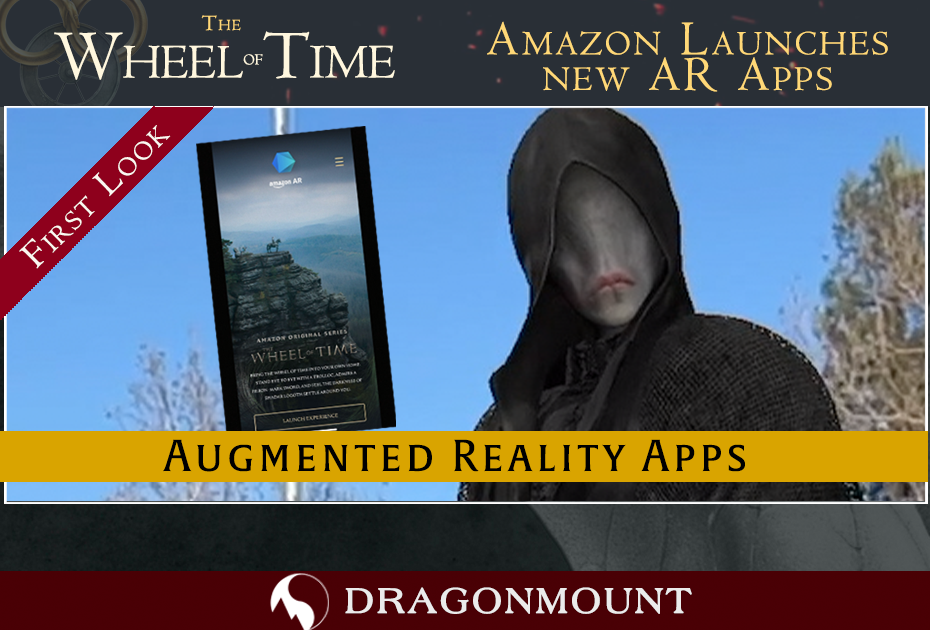
Katy is a news contributor for Dragonmount. You can follow her as she shares her thoughts on The Wheel of Time TV Show on Instagram and Twitter @KatySedai Dragonmount Exclusive Reveal Amazon has released a new app for IOS and Android that brings The Wheel of Time TV show to life on your phone or other mobile devices. There are thirteen augmented reality experiences including creatures, artifacts, and locations from the TV show. March 2022 update: Amazon has temporarily removed these apps from the App Stores. They're focusing on building new experiences for WoT and other shows. These Wheel of Time experiences are expected to return, probably as we get closer to Season 2. For example, the interactive app places a Trolloc in your living room (don’t get too close or it might snarl at you). You can get a bird's eye view of Tar Valon in your kitchen, or explore the ruins of Shadar Logoth in your basement. You also can learn about weapons and jewelry from the TV show. The app allows you to save and share your own video clips and photos from the app. If you share on social media, then tag us @dragonmount_ on Instagram or @dragonmount on Twitter. Head over to Dragonmount’s YouTube channel to learn more. Ready to try it? Get started with the iOS app or the Android app and then let us know in the comments or on our forums below what fun things you found!
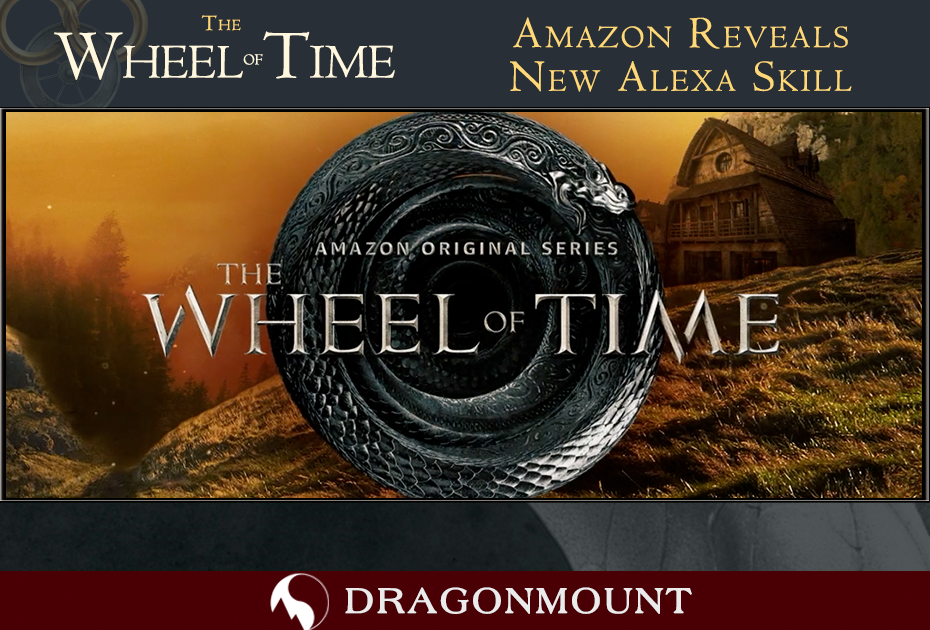
Katy is a news contributor for Dragonmount. You can follow her as she shares her thoughts on The Wheel of Time TV Show on Instagram and Twitter @KatySedai Dragonmount Exclusive Reveal Not ready to leave the world of The Wheel of Time quite yet? If you have an Amazon Echo Dot or other Alexa-enabled device you can discover the new Alexa Skill, Beyond the Two Rivers. Although the experience is best used with an Amazon Echo device, this will work with mobile devices using the Amazon app as well. This interactive tour allows you to experience the people, places, and music of the Two Rivers as seen in Amazon Prime Video’s The Wheel of Time TV show. The experience puts you in touch with a retired Gleeman who will explain information and trivia about the world. To begin this journey, first enable to Alexa Skill on the Amazon website. Make sure to do this with the same Amazon account that your Alexa-enabled device uses. Next, say “Open Beyond the Two Rivers” to your Alexa-eaned device. This will begin your guided conversation about The Wheel of Time. You can say things like “Tell me about Bel Tine” or “Let’s meet Rand.” There’s lots to explore including information about Tinkers, Aes Sedai, and Darkfriends! We've created a video showing you how it all works: Ready to try it? Get started here and then let us know in the comments or on our Forums below what fun things you found!

In a special episode of the Dragonmont Wheel of Time Podcast, producer Kathy Campbell had the opportunity to speak with Taylor Napier, who plays Maksim—one of Alanna's warders—in the Amazon Prime Video Wheel of Time television series. Or you can view it on YouTube here. You can also listen to this episode of the podcast here! Kathy was able to finally tackle that burning question on all our minds: why does Alanna have so many snacks? (And we're not just talking about her warders.) The Dragonmount Podcast has an episode of discussion for each of the television show episodes, with more interviews and speculations coming soon. Keep up to date with all the podcast episodes here. Would you enjoy seeing Maksim featured as a more central character as the series progresses? Let us know in the comments below!

Adam Whitehead is Dragonmount's TV blogger. Adam has been writing about film and television, The Wheel of Time, and other genre fiction for over fifteen years, and was a finalist for the Hugo Award for Best Fan Writer in 2020. Be sure to check out his websites, The Wertzone and Atlas of Ice and Fire (including The Wheel of Time Atlas!) as well as his Patreon. The Wheel of Time first season finale gives us the first look at the Age of Legends, the storied era of history that ended in the Breaking of the World and the corrupting of the male half of the One Power, some 3,400 years before the start of the main story in the books. It’s only a brief glance – we have less to go on here that during our previous deep dive on Tar Valon – but it’s an interesting look at one of the more intriguing parts of the backstory. It appears that this city is Paaran Disen, the greatest city of the Age of Legends. During the Second Age, the idea of nations and kingdoms disappeared and the whole world was united under a single global government, albeit a relatively loose one. That government was based in Paaran Disen, which was also the location of the Hall of the Servants, the ancient equivalent of the White Tower. The Hall of the Servants was merely the headquarters of the worldwide guild which was the Aes Sedai in that Age, rather than being the home for all of them as the White Tower is. With 3% of the population serving as Aes Sedai, their numbers ranged comfortably into the millions, if not tens of millions, and most lived in their own homes, pursuing careers which may or may not have been related to the Power (Lillen Moiral – Moghedien – was an investment banker, despite being a powerful channeler, whilst Mierin Eronaile – Lanfear – was an advanced researcher into new applications of the Power). Paaran Disen was effectively the world’s capital, although it is unclear that the population of the world in the Age of Legends was, if it was comparable to our own (with more than 7+ billion people) or if improvements in birth control, medical technology, Healing and sustainability meant the population was less than during our age. This may explain why Paaran Disen appears to be a somewhat small city by our standards, though still enormous by the standards of the Third Age. Of course, the building where Lews Therin meets Latra Posae might be on one edge of the city and the city sprawls for a considerable distance in the opposite direction which we don’t get to see. In the books, Paaran Disen had many of the hallmarks of civilisation in the Age of Legends. Many of the streets and parks were lined with chora trees, which gave a sense of peace and well-being to those who sat in their shade. The buildings were tall, ornate and beautiful, many built of elstone, which made them shimmer in the light. The entrance to the Hall of the Servants was flanked by tall columns. The city was divided by roads along which vehicles such as jumpers and jo-cars could travel. As the grandest city in the world, Paaran Disen was also served by transport such as sho-wings, great delta-winged vehicles capable of carrying up to hundreds of people anywhere in the world in short order. The city also had numerous locations marked for Travelling, allowing Aes Sedai to open portals directly to wherever they wanted to go. Above: Paaran Disen in the opening of the first episode. Below: The same city in ruins in the prologue to the season finale. During the War of the Shadow, Paaran Disen served as the base of operations for the Light against the Dark One’s forces. Lews Therin Telamon, First Among Equals of the Aes Sedai and effective military commander of the forces of the Light, the man history calls “the Dragon,” seems to have made his stand in Paaran Disen, indicating it was located far from the front lines of the war, at least when it began. At a key point during the war, the forces of the Shadow reached Paaran Disen and achieved a major victory. However, Lews Therin was able to defeat Elan Morin Tedronai, known as Ishamael, before the gates of Paaran Disen, indicating the Shadow was not able to exploit its victory and hold the city. Be’lal later led an assault that managed to at least partially destroy the Hall of the Servants, although enough of the building survived for it to continue to serve as the Aes Sedai’s headquarters. Later, during the closing stages of the war, Lews Therin’s strike on Shayol Ghul gave hope that the conflict was about to end. Although the assault successfully patched the Dark One’s prison and cut off the entity from its followers, the Dark One was able to corrupt saidin, placing a rotting taint on the male half of the True Source. Every male channeler in the world started to go insane. Within days or weeks, people were fleeing the city en masse. Several former male Aes Sedai apparently levelled the city with the One Power afterwards in their insanity. Whatever survived was obliterated in the Breaking of the World. By the end of the Third Age, not a single trace of Paaran Disen remains and its relative location in the new world is completely unknown. It might be at the bottom of the ocean or buried under the Spine of the World. In the TV canon, whilst the War of the Shadow has curiously not been directly mentioned so far, it is unclear how much of this remains true. The city appears more peaceful than you might expect at the end of a ten-year war (and a century-long societal collapse preceding it) which has seen the city attacked several times already, and there are more jo-cars and jumpers and hoverflies in the sky then apparently was the case at the end of the war, when the Shadow overrunning or destroying factories and industrial areas had forced many of the armies of the Light to rely on swords, bows and horses instead. The name of the city is also interesting. “Paaran Disen” suggest “Paradise,” whilst “Paaran” means to mate or to pair in German, potentially a reference to the gender parity of the Aes Sedai in this Age. “Disen” may be derived from the Dísir of Norse mythology, a vein of myth that Robert Jordan mined for many ideas and names in The Wheel of Time. In the TV image you can also see a sports stadium, roads and plenty of tall buildings whose shape and size are echoed in the White Tower of Tar Valon, built three to five centuries later with the last vestiges of knowledge from the Age of Legends. The vibe is a sort of timeless Greco-Roman elegance, fusing the old and the futuristic, which certainly seems to fit what Robert Jordan describes in the novels. More interestingly, if you go back to the end of the prologue to the first episode, we get to see the same city in a state of dilapidated disrepair in the modern age. Most of the buildings map 1:1 on the buildings from the later image, with a few exceptions which were destroyed or have been lost to the overgrowth of trees and vegetation. The buildings’ outer shells have been stripped away or destroyed, leaving behind only the cores. This is of course a deviation from the book situation, where Paaran Disen was destroyed by crazed male channelers and then whatever was left behind was completely obliterated in the Breaking of the World. It is no longer possible to say where Paaran Disen was in relation to other locations. In the TV show, the ruins of the city are still standing, though it is unclear where (it is from this location that Moiraine and Lan set out to travel to the Two Rivers, but it is not said if that was a lengthy journey across the entire continent or a closer location). This immediately sells the “post-apocalyptic” vibe more obviously than the books do, as the books wait a while before bringing in ruins and artefacts from the Age of Legends, or even our Age which precedes it. The production team have indicated we will see more of the Age of Legends later in the series, and it’ll be interesting to see how they continue to realise it on-screen. As usual, please continue to follow developments on our casting and news pages, and the forum, and stay tuned for more info as we get it.
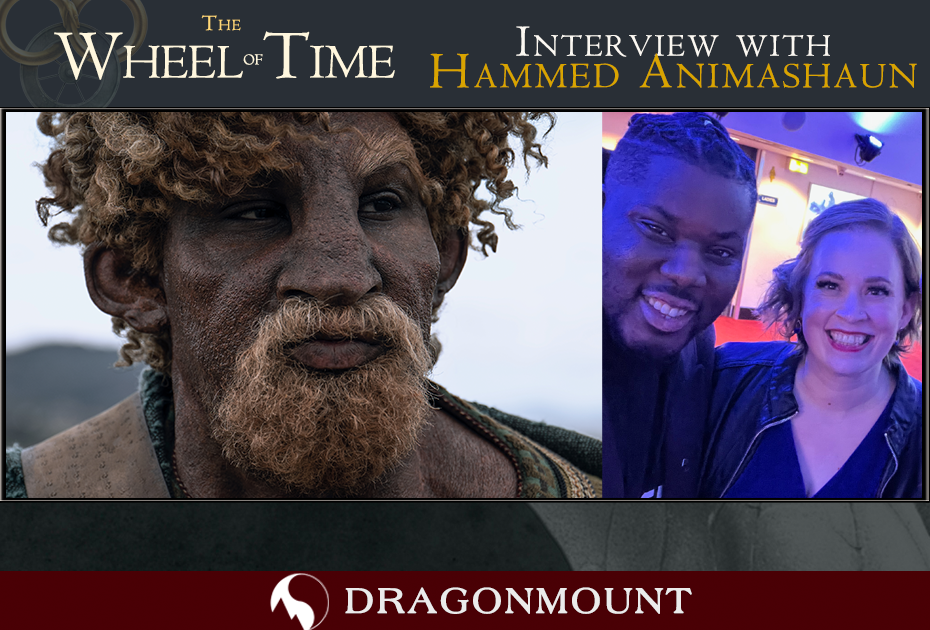
In a special episode of the Dragonmont Wheel of Time Podcast, producer Kathy Campbell had the opportunity to speak with Hammed Animashaun, who plays Loial in the Amazon Prime Video Wheel of Time television series. Or you can view it on YouTube here. You can also listen to this episode of the podcast here! The Dragonmount Podcast has an episode of discussion for each of the television show episodes, with more interviews and speculations coming soon. Keep up to date with all the podcast episodes here. How satisfied are you with Hammed Animashaun's performance as Loial so far? Let us know in the comments below!
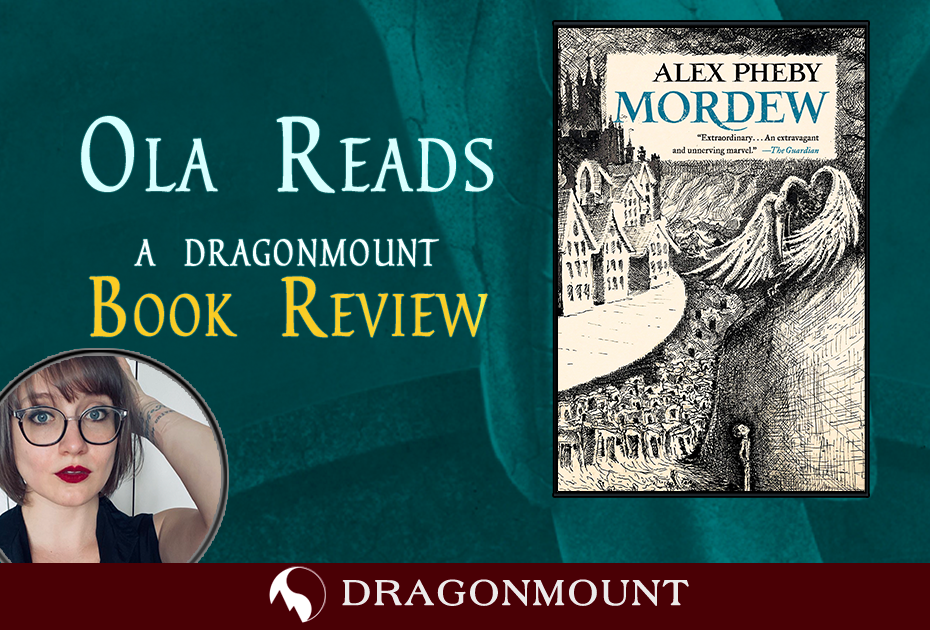
Aleksandra (Ola) Hill is a Polish-Canadian writer and the founder and editor-in-chief of khōréō, a magazine of speculative fiction by immigrant and diaspora writers. She won the grand prize in the 2019 Writer’s Digest Popular Fiction Awards and is currently pursuing an MFA in writing at The New School. You can find her on Twitter at @_aleksandrahill. # TL,DR: Mordew by Alex Pheby is a grim, subversive fantasy about a young boy, Nathan, who lives in the slums of the eponymous city and bears a magical Spark. It's a solid read for those who aren't looking for a lighthearted escape, who are comfortable with stories that don't give all the answers and are told at an emotional distance. # Mordew is a hefty first entry of the Cities of the Weft trilogy written by Alex Pheby. It follows Nathan Treeves, a young boy living in Mordew with his mother and very sick father. The world-building is gloriously grimy, reminiscent of the cover itself: all grays and grimness. Living Mud coats the streets of the slums that Nathan calls home; this mud can spontaneously create mutated-looking creatures called dead-life that may or may not remain viable. At the start of the book, we see Nathan wading into the Circus on the west side of Mordew to 'fish' for self-sustaining dead-life: anything he might sell to purchase the medicine his father needs. Nathan can Spark—call up some sort of wild magic from deep within himself—and, in spite of his father's command never to do so, uses this ability to find one such creature. It is "a bundle of infant limbs—arms, legs, hands, feet—a tangle of wriggling living parts" (p.23) made even more horrific by Nathan's cavalier attitude towards it. He sticks it into his bag and trots off to sell it; such abominations are commonplace in this world. The services of the medicine woman he purchases with the money from the sale is insufficient. Thus, in order to pay for her husband's medicine, Nathan's mother sends her only son to the mysterious Master who rules over the city in hopes that Nathan will be chosen—for what? Nobody really knows, but needs must: a consistent refrain of Mordew. A sense of hopelessness runs throughout the story and never truly goes away; this isn't a book—or, presumably, a series—made for happy endings or shiny, escapist magic. Just as Nathan fights constantly for his own survival and that of his father, so too does the Master of Mordew fight a seemingly eternal war against the Mistress of Malarkoi, who sends Firebirds to break the city's walls. There is little room for love or joy in these pages, so if that's something you're looking for, then this isn't the novel for you. It also isn't for readers who want all the answers. The book begins with a very clear warning: to take care in referencing the glossary, which clocks in at over 100 pages long, as it contains information that the protagonist doesn't know; and that "perhaps the ideal reader of Mordew is one who understands that they, like Nathan Treeves (its hero), are not possessed of all knowledge of all things at all times. They progress through life in a state of imperfect certainty and know that their curiosity will not always be satisfied immediately (if ever)" (p.7). My memory isn't the best, so I'd forgotten those cautionary words by the time I was a bit into the book. It wasn't until I rediscovered it that I felt like I understood the author's intent. To put it plainly, the reading experience, after the first few pages, feels like one is observing the action through a thick pane of glass. Nathan's feelings are, for the most part, inaccessible, though the reader follows him closely throughout the story. This often felt frustrating, as the character's reactions and motivations were, for the most part, opaque. For example, one character dies in a fall, seemingly pushed by another who had already shown rather suspicious tendencies. Nathan and an accomplice conclude that they have to confront the "pusher" to understand what happened, rather than dismiss them as a traitor. While this might certainly be a reasonable reaction, especially given the child in question is a lonesome one who might be desperate to cling to any semblance of friendship, it felt like it was left up to the reader to ascribe motive and rationale to the actions rather than truly understanding them. The same is true of Prissy, the book's primary love interest: Nathan's devotion to her is clear, but it's hard to understand why it exists and, thus, to truly feel it. At first, I thought this might be because the author was hesitant to write the inner monologue of an impoverished thirteen-year-old boy—which seems somewhat understandable, given how a combination of desperation and Big Teenage Feelings might be hard to do without veering into the maudlin. But I think, given the introductory warning, it's a more purposeful move on the part of the author. The narrator itself seems to confirm this by not being as close a third person as one might initially expect; at least twice, the book reveals moments that "Nathan saw none of" (p. 380) but that the reader has clearly witnessed. It's unclear who, in fact, is telling us the story—one character is conscripted to help with a task, but "he was sworn to secrecy on the matter, so no more will be said of this." The magic system, too, is tenuous at best, the reader's knowledge of it as patchy as Nathan's. The book is a consistent exercise in incomplete information, whether on the part of the characters or the reader. Ultimately, this construct doesn't work for me simply because it doesn't give me the emotional investment that I (personally) need as a reader. Being on the outside like this makes it feel like I am seeing the hand of the author too clearly, like he is moving chess pieces around on a board in order to progress the plot in a way that he deems fit. I was drawn to the beginning of the novel, yet felt myself dragging through the vast majority of the rest of it, with the exception of several sections. Indeed, the word that stuck out to me most at the start of the novel was "purpose"; the text questioned what function a machine, or a chain, or some other object performed, often without providing an answer. The author appears intent on subverting the idea of purpose. You can't truly know what function everything in the world has, and thus you can't know what you're doing or what effect it'll have on the future. There's a potential pointlessness to everything our hero does, then, that speaks to an existential ennui. That's not necessarily a bad thing, but it's certainly not for everyone, and it wasn't what I needed or wanted two years into a pandemic. Still, the ending of the book felt immensely satisfying in that I understood, I think, what the author wanted to achieve, and I believe that he achieved it. Teasing apart what in the novel worked for me and what didn't was deeply delightful in and of itself, and even though I don't plan to continue reading the series, I'm glad that I pushed through. At my most judgmental point of reading, I might have said that this book is one for those insecure about loving genre, who need to prove to themselves or others that fantasy can be 'literary' in the way that any depressing story seems to be when contrasted with a joyful one. But I think that does Mordew a disservice: it is a book for those who realize that, if magic were real, not every story would culminate in a satisfying hero's arc complete with enlightenment. We might begin in hopeless circumstances with no guidance, leaving us to use our adolescent imaginations as best we can to figure out what to do and take our beatings when we get it wrong. It isn't satisfying, per se, but it is an exploration that might provide a sort of pleasure to a certain sort of reader. For those intrigued by such a premise, I recommend Mordew heartily. Mordew is available in the Dragonmount eBook store. Find it here!
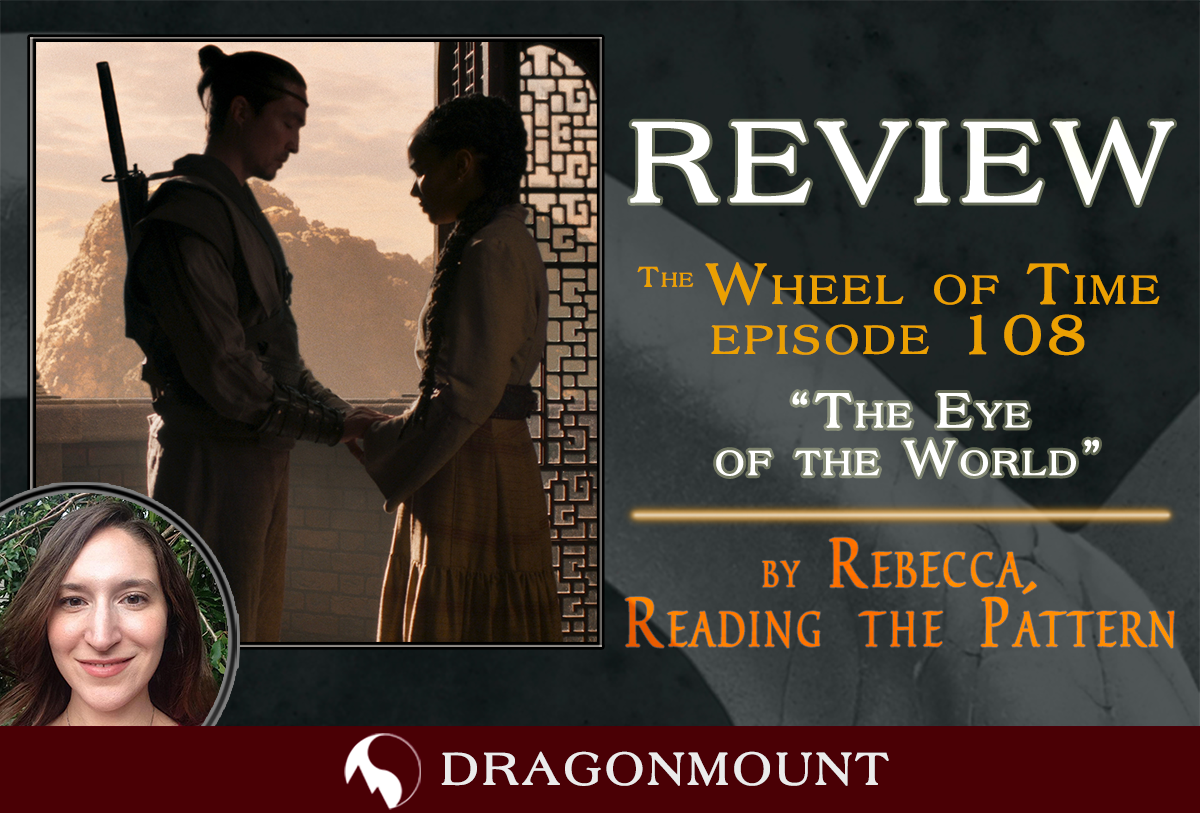
Rebecca is a social media contributor at Dragonmount. Subscribe to her channel, Reading the Pattern on YouTube. The weight of expectations from long-time fans of The Wheel of Time book series going into this season 1 finale episode can’t be overstated. I wouldn’t be surprised to find this episode the most polarizing of the season, depending on how much your metaphorical loins were girded for changes heading into it. Speaking for myself, I was a huge fan of the setup we got in episode 7, “The Dark Along The Ways,” the ending of which had Moiraine heading into the Blight with Rand alone, her Bond to Lan masked. This prepared me for not having the whole group journey to the Eye. Knowing that the unexpected departure of Barney Harris as Mat would necessitate rewrites also prepared me for differences. To be honest, I didn’t have a lot of specific expectations for how the plot of the season-ender would play out. I always felt certain aspects of the ending of The Eye of the World were confusingly written and wouldn’t play well on screen and this was an opportunity to streamline. As it turned out, I was a huge fan of the way one major change in particular played out, and confused by one or two others. But ultimately, the episode needed to provide a satisfying conflict between Light and Shadow, hit some key character moments, and leave us questioning and wanting more. On all of those points it delivered. The cold open had us jumping back 3,000 years to the Age of Legends and the final confrontation between Lews Therin Telamon and Latra Posae Decume, notably portrayed by Alexander Karim and Katie Brayben in the Old Tongue. This is a scene that hinted at but does not explain the full context of this argument. Lews Therin has a plan to cage the Dark One that Latra Posae believes is too risky and arrogant and will not support. Lews Therin is undeterred by her refusal and as he tells his infant child, he means to do what he believes is right to protect them anyway. Following this scene, we know that Lews Therin led his strike with only 99 male Companions, because Latra Posae convinced all the female Aes Sedai to side with her. The Dark One’s counterstroke caused the corruption on the male half of the One Power, which led to the Breaking and why men can no longer channel without eventually succumbing to madness. I believe most of the above can be gleaned from the scene itself and by other information we are given throughout the season, but I am curious to see what the reaction to this scene will be from non-readers. At this point in book history the devastating War of Power had been fought for at least the past 10 years and there was no evidence of that in this scene. Perhaps they are changing this history in order to better show the height of the Age of Legends. That was one aspect of the scene that I did really enjoy seeing, the costume and set choices and the vista outside the window which all perfectly convey a futuristic and timeless quality, and better establish the primary timeline as post-apocalyptic. But perhaps there was a missed opportunity to better convey the stakes and the tension in this conversation between Lews Therin and Latra Posae if they had retained the wartime element. The biggest focus of the episode, rightly so, was Rand and Moiraine in the Blight and at the Eye of the World. Rafe Judkins spoke in an interview with Nerdist about the decision to put Nynaeve and Egwene at Tarwin’s Gap and Perrin and Loial recovering the Horn of Valere, instead of journeying with Rand. Ultimately I liked the decision to have core characters to focus on in each location and to allow for deeper development of Rand and Moiraine particularly with the tighter focus on them. The claustrophobic set choice for the Blight worked well for scenes between two, but if they had journeyed as a group, it likely would not have allowed for scenes such as the one between Lan and Nynaeve before she sends him off into the Blight hoping he will bring Rand back. That scene was everything book fans will have been hoping for, right down to some exact quotes from Lan many of us might have memorized. It’s the culmination of something the show has given us that the book could not, watching the development of Lan and Nynaeve falling in love. But as all season finales should do, it also leaves us wanting more. As for Rand and Moiraine, we got to see some wonderfully subtle character moments from them, such as Rand finding the strength to tell Moiraine to stay behind when they reach the Eye and her disregarding his attempt to protect her. And the reversal of Rand asking for answers Moiraine will not give at the start, to her final question of him, “Where will you go?” And his reply, “Goodbye, Moiraine.” But the heart of it comes in each of their interactions with The Man at the Eye (Fares Fares). One of my favorite decisions in this adaptation thus far is to change Rand’s confrontation at the Eye to one of a psychological and moral struggle, not a battle with the One Power. It ties in perfectly with major themes from the books and ultimately Rand’s decision to leave the vision of the perfect life he dreams of because he recognizes that Egwene would choose differently is a beautiful one. For Moiraine’s part, she is immediately left with few choices as she is cut off from channeling. The Man taunts her with her lack of knowledge of whether Rand will choose the Light or the Dark, and while she makes clear she is prepared to kill Rand if he does choose the Shadow, the uncertainty she faces brings the tension to a razor’s edge. As the episode goes on the scenes cutting back and forth from one subplot to another get shorter and shorter as the tension increases. Finally, Rand stands between The Man and Moiraine and while it may seem Rand has defeated The Man too easily, we can see a subtle hint of a smile on The Man’s face as the cuendillar seal beneath their feet cracks. Perhaps this has been his plan all along. While I loved the Moiraine and Rand threads in this episode from start to finish, the other threads were more mixed for me. Perrin had a lovely moment with Egwene at the beginning of the episode, offering her unconditional friendship, which I felt was a perfect cap to the threads left hanging off the blowup up between the Two Rivers characters in episode 7. But he did languish a bit in the middle of the episode. Loial got a chance to say the right thing at the right time to Perrin, telling him if he wants to help but doesn’t know how, simply to ask. This leads them to help Uno and his small group of Shienarans recover the Horn of Valere. Unfortunately, Perrin’s hesitation to pick up an axe may have cost some of those men their lives when Padan Fain and two Fades attack and steal the Horn. Fortunately, Rafe Judkins confirmed to Comic Book Resources that we did not see the end of Loial son of Arent son of Halan. I wouldn’t want to see the fan riot if they had killed our beloved Ogier in this way. Fain’s monologue to Perrin, before he escapes with the Horn (and the Shadar Logoth dagger!) was a fantastic way to finish the main action of the episode. He confirms his own status as a Darkfriend and that the Shadowspawn were not sent to kill the five of them, but to bring them to the Dark One. He believes at least one of them will turn to the Dark, which is said ominously over the only sight of Mat in the episode, a shot of him walking through Tar Valon, looking rougher again and hinting at where things may pick up for him in season 2. It is these words from Fain which finally convince Perrin to pick up that axe and that is a momentous moment for him given the journey he has been on this season. The battle at Tarwin’s Gap had some cool moments, though the combat scenes seem to have suffered slightly due to the reality of Covid-19 restrictions, preventing the use of stunt performers as Trollocs. Instead, CGI was used for the Shadowspawn in these scenes and as a result there was less ability to do shots of close combat, such as we saw in episode 1. The loss of Agelmar was effectively set up by the scene earlier in the episode between him and Lady Amalisa. But it was Amalisa’s role in the battle that packed the most punch. Seeing her ready the women of the city in her father’s armor, and then the beautifully shot scenes of her leading a circle of women and channeling an immense amount of power to destroy the wave of Shadowspawn that broke through the fortress was awesome. We get to really see how dangerous and seductive than much of the Power can be, as she burns out not only herself but two of the other women linked to her. That brings me to the one aspect of this episode I really can’t get behind. Nynaeve and Egwene as part of this circle can feel themselves starting to burn out as well. Nynaeve says a touching goodbye to Egwene as she takes the Power running through Egwene into herself and then it appears Nynaeve is burned out and/or killed as well. Egwene certainly seems to think so, but yet she channels and her weaves Heal Nynaeve. In hindsight it is absolutely clear that Nynaeve never was burned out or dead, only injured, and this much Egwene has managed to Heal. However, the scene was certainly presented in a way to make the audience think Nynaeve was dead or at least burned out and these things Egwene should not be able to Heal. I simply don’t think the fakeout was necessary and it may have cheapened the moment as well, particularly in an episode where we have some other apparent deaths (Loial and Uno) which will turn out not to be fatal. In contrast, I can appreciate the decision made to leave what exactly has happened to Moiraine uncertain. As she tells Lan when he finds her, she can no longer channel. From what we saw The Man do to her and from what we have seen previously of both shielding and severing with Logain, it looks most likely to me that Moiraine has been shielded and the weave was tied off so that its effects continue even though The Man is no longer there to maintain the shield. It is also possible, however, that she has actually been stilled. Either way, there is real heartbreak in the moment when she tells Lan she cannot unmask the Bond and they can no longer feel what the other one feels, on top of Moiraine’s own terrifying loss. I can understand why the show may want to leave this vague for the moment as a hook for next season. Whatever has happened to her will almost certainly inform her plot going forward, and it will be fascinating to see what Moiraine will do when she does not have access to this ability. Finally, we get the ominous epilogue which introduces us to the Seanchan fleet and a somehow even more horrifying than expected glimpse of the damane and sul’dam as they approach the Western shore. Another effective hook for next season. “The Eye of the World” was an episode that made some bold choices in the writing by Rafe Judkins, most of which paid off or we can expect to pay off in next season. The production faced some real challenges in this episode, from the pandemic restrictions to the sudden loss of a core cast member (Barney Harris) necessitating rewrites. Those challenges for director Ciaran Donnelly showed more in this episode than it did the previous one, which I found nearly perfect, but the scope of what he was trying to accomplish in this one was also greater. As hard as it is to finish a season and be left with burning questions that will not be answered for many months, I am glad to be in that position, wondering. Where will Rand go now that he has set off alone, wanting the others to believe him dead? I expect Perrin will be on the hunt for the Horn of Valere but who will join him? How will Mat be woven back into the story? What will Nynaeve and Egwene face in the White Tower? How will Moiraine fare without being able to channel? How will the loss of the Bond and Lan’s feelings for Nynaeve affect his relationship with Moiraine? The beauty of this adaptation so far is that even book readers don’t know exactly. Mystery and speculation have always been and will continue to be major draws that keep fans hooked on the series. I can’t wait to see what this team can do as they get deeper into the book material. Bring on season 2!
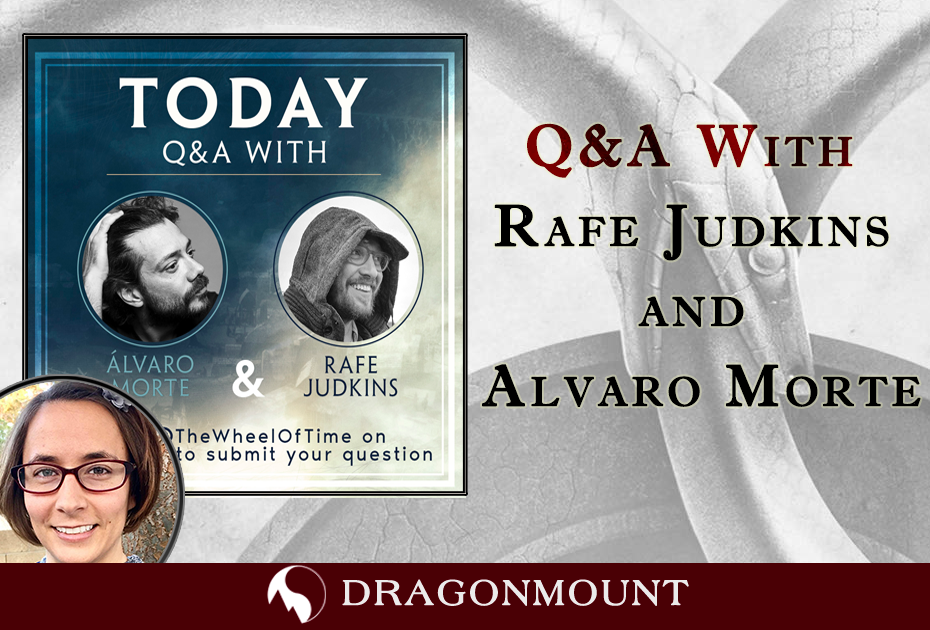
Today, Rafe Judkins—the showrunner for Amazon Prime Video’s Wheel of Time television show—and Ȧlvaro Morte—who plays Logain Ablar in the show—participated in a Q&A session on Instagram. Topics ranged from casting choices to bonus content, and everywhere in between. Here are a few questions and answers: Question: Has season 1 performed as you expected? Any thoughts on viewers’ feedback? Answer: When we started out, we knew the show had to appeal to a huge audience in order to justify its existence. So we always imagined that we’d likely lose absolute hardcore book fans who’ve read the series multiple times because the show would be too different from the books. And conversely, that we’d lose people who’ve never watched a fantasy show before because it’s too much like the books (which are very high fantasy). The target was always more people who read some or all of Wheel years ago or are fantasy/genre fans but not familiar with Wheel. Which is a huge breadth of people. The shocking thing to me has been how many really really Sarah Nakamura-level hardcore book fans have loved the show despite the departures and how many people who’ve never watched a fantasy show before in their lives are somehow finding their way to this one and loving it too! -Rafe Question: Rafe – any plans to continue or even expand on the animated origin stories? They r AMAZING Answer: We are actually talking with Amazon now about a way to make these even bigger and better in S2. Rammy Park, Mike Weber and the Amazon X-Ray team have been incredible in putting them together and I want MORE. -Rafe Question: When will we see Logain again? Answer: Sooner than you expect but later than you wish. -Rafe Question: How many seasons ahead are you thinking when making decisions? Answer: All of them. Have to be. There’s lots of stuff that we’ve set up in Season One that are changes from the books that we needed to make for later payoffs. -Rafe Question: What drew you to playing Logain? Are you excited for his later character development? Answer: Logain is an amazing character. He is full of possibilities in terms of acting. It’s a gift for an actor to get the chance to perform a character like Logain and follow his development. -Ȧlvaro You can read the entire Q&A here. As a Logain fangirl, I'm very excited that he'll be back sooner than expected! Make sure to keep up to date on all the details of each episode on Dragonmount’s Season 1 episode guide, join the TV show discussion on our forums, or follow us on social media: Facebook, Twitter, Instagram, TikTok, and Youtube. What are your thoughts going into the Season 1 finale and your hopes Season 2? Let us know in the comment below.

Adam Whitehead is Dragonmount's TV blogger. Adam has been writing about film and television, The Wheel of Time, and other genre fiction for over fifteen years, and was a finalist for the Hugo Award for Best Fan Writer in 2020. Be sure to check out his websites, The Wertzone and Atlas of Ice and Fire (including The Wheel of Time Atlas!) as well as his Patreon. We said previously that it’s a hit, but it’s turned out to be an even bigger hit then we thought: The Wheel of Time has had the biggest and most successful launch of any original show in the history of Amazon Prime Video. That’s a pretty big deal. Previously Amazon had only committed to saying that Wheel of Time had the biggest launch of any original show in 2021. That puts Wheel of Time ahead of big shows like Invincible and Clarkson’s Farm. However, the new information now means that Wheel of Time has had a bigger and more successful launch than shows like The Expanse, The Marvelous Mrs. Maisel, The Grand Tour, The Man in the High Castle, Carnival Row, Bosch, Tom Clancy’s Jack Ryan and their previous biggest hit, The Boys. The news will be welcome to Amazon Prime Video and Sony Television, who took something of a gamble on greenlighting the show with a budget of over $10 million per episode and filming on multiple locations across Europe, based on a series of fifteen novels that have sold around 90 million copies and have passionate fans around the world, but were perhaps not household names. Unlike the previous fantasy megahit, Game of Thrones, which based its initial appeal on little to no magic, no supernatural creatures and a focus on sex and politics, The Wheel of Time is unashamedly a broad, epic fantasy with vast displays of sorcery, a nonhuman creature as a regular character and an up-front commitment to showing epic battles in challenging locations. It also bodes well for Amazon's commitment to genre programming. Although The Expanse is wrapping up after three seasons on the streamer, Carnival Row is due to launch its second season next year and The Boys its third. More germanely, Amazon is also planning to launch its Lord of the Rings prequel series, about the Second Age of Middle-earth, on 2 September 2022. With a budget conservatively estimated at three times that of Wheel of Time (and possibly a lot more), there's a huge amount riding on that project. Wheel of Time getting more people watching Amazon Prime's video channel can only be a good thing for that project and for the other SFF shows they have in development, including an ambitious Mass Effect TV series, based on the video game series. If Amazon are considering any other fantasy projects – they recently dropped a Conan the Barbarian project which has since been swept up by Netflix – this may encourage them to commit to them further. The Wheel of Time has already been renewed for a second season, which is now more than halfway through shooting in the Czech Republic, although contrary to some reports it has not yet been renewed for a third. With this news, a third season renewal and hopefully more beyond now seems much more likely. The final episode of the first season, The Eye of the World, will drop this coming Friday. Season 2 of The Wheel of Time is expected to air in late 2022. As usual, please continue to follow developments on our casting and news pages and the forum and stay tuned for more info as we get it.
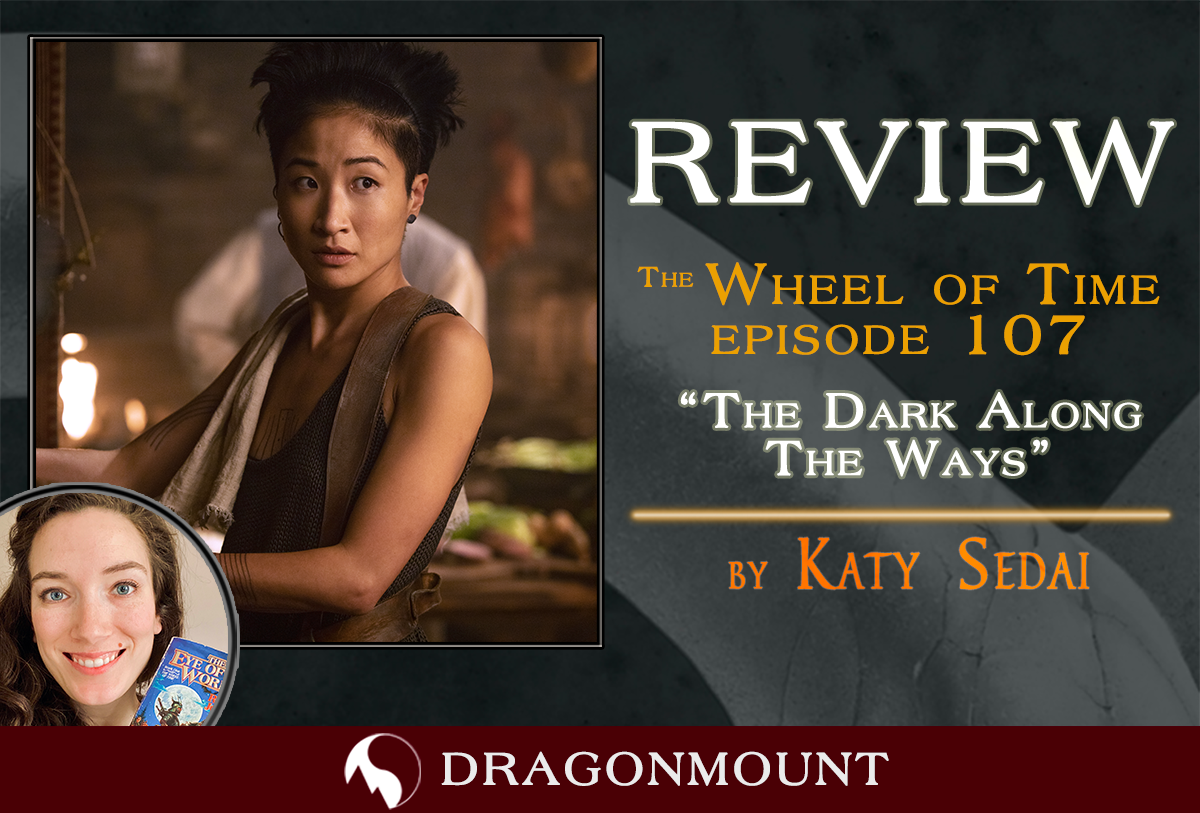
Katy is a news contributor for Dragonmount. You can follow her as she shares her thoughts on The Wheel of Time TV Show on Instagram and Twitter @KatySedai The penultimate episode of The Wheel of Time television series, The Dark Along the Ways, begins with a cold open that pushes the previous episodes aside. Snow and Blood - a fight scene unlike any we’ve seen so far this season - a lone Aiel Maiden of the Spear, in labor, fighting off soldier after soldier. Episode seven is the first episode made after the “Covid break” in production due to the global pandemic. And rather than diminish the quality of the TV show, if anything, the break amplifies the show, raising production quality, the story, and the acting. This first scene exemplifies the improvement. The directing from Ciaran Donnelly is amazing, and I hope to see more fight scenes in this style in the future from the show. Stuntwoman Magdalena Sittova, who plays Tigraine Mantear, was incredible, her athleticism shone and the relief on her character's face when Tam reaches out to help her birth her baby absolutely broke my heart. Many fans will be happy to see such an epic depiction of the blood snow since it’s such an iconic scene from the books. After the cliffhanger with a sword to Tigraine’s throat, we move back to our main storyline and the Ways. This was another iconic space that many book fans were looking forward to. As part of the time gap due to the pandemic, they also had time for rewrites. Barney Harris’ Mat Cauthon doesn’t appear in this episode at all, so it does seem we won’t see Mat until season two when Dónal Finn will reprise the role of Mat. It’s a disappointment they had to write Mat out of the story, but the break gave the writers time to edit. “We didn’t leave him, he left us” says Egwene about Mat, but I wonder if that also applies to Barney. The Ways sequence felt fairly short, and the addition of ramps might have added to the 3D space they occupy. The show introduces a new interpretation of Machin Shin. One that literally speaks to your deepest fears and insecurities. The repercussions of Machin Shin’s whispers were felt throughout this episode. Making the Black Wind personal rather than generically creepy and blood thirsty was a great change, and just another way the book material can be improved moving to a new medium. The added peril of Machin Shin gave the group a reason to go to the borderland city of Fal Dara and not straight to the Eye. Our team of weary adventurers then arrive in the fortress city of Fal Dara where we meet some beloved book characters, including Lord Agelmar (played by Thomas Chaanhing), and fan favorite, Uno Nomesta (played by the Guy Roberts, the wonderful flaming bastard). One change I’m uncertain about is the animosity between Moiraine and Lord Angelmar. But like most changes, the conflict needs a bit of time to develop and see where it goes. It’s hard to judge changes on just one scene. The sets of Fal Dara are rich and detailed. You can clearly see that the style is different from Tar Valon. This is the look at a new country, and down to the designs in the windows, there’s a new style and geometric angularity. Fal Dara looks like a real fortress city. Moiraine next takes her band of Two-Rivers folks to see Min Farshaw, Seer and bartender, hoping to determine if any of them are the Dragon. Min has visions for all five of them: Perrin with goldeneyes and blood down his chin, Rand rocking a dark haired baby, a white flame and golden ring for Egwene and Nynaeve, and finally, The Amyrlin Seat in full regalia that will be Moiraine’s downfall. In the books Min’s visions are glimpses of the future that foreshadow certain events, but not always in the way you’d think. It seems the TV show is going for the same feeling here. Book readers may think we know what these all mean, but is what we see really the way it will play out? Kae Alexander plays Min a little tougher, a little more world-weary than the Min in the books. It seems like Min has a job and is running a successful bar. It will make her future decisions hold more weight since she has independence and a life here in Fal Dara. It was never clear to me what exactly she was doing in the Inn in Baerlon. She felt too vulnerable to being swept up in the Ta’verens’ wake. Now perhaps she will have to make a more conscious decision to leave her life. Let’s now talk about maybe my least favorite part of the story yet. The Perrin-Egwene-Rand love triangle. This bit felt lazy and unnecessary. There’s a need for conflict among the Two-Rivers folks, but this really felt contrived for TV, and I honestly hate it. There’s enough love triangles in the future that we don’t really need Perrin getting involved here. A bit of this may be leftover effects from the Black Wind, but I still don’t like it. Romance I do like - Lan and Nynaeve!! There was a part of me that was hoping for some of the lines we see at the end of The Eye of the World. But the scene of them having dinner with Lan’s friends was lovely. The TV show is actually developing this romance, rather than just randomly having them declare their love (ahem, EOTW). The show has really outlined what draws these two characters together: their dedication to the people they love, their protectiveness, and their drive for others. The relationship is very believable and real. As a book reader, I was hoping to see the romantic relationships improved in the show. Many of the relationships happen in the books with little to no warning, and people fall in love at first sight. Robert Jordan does a good job developing believable platonic relationships, but his romances generally fall short. It’s nice to see the show take the nuggets from the books and expand them into full fledged relationships. The show is also doing this with Egwene and Rand’s relationship. They are coming to the same conclusions they do in the books, that they likely can’t be together the way they want. But they actually talk to each other. There’s little lines of dialog that makes it feel real - Rand saying to Egwene that he knows she’ll come to him when she’s ready to talk. Which is exactly what she did. They really do know each other and have an established relationship. Thankfully they also shut down the Perrin love triangle pretty fast. About this point I was starting to get worried about the pacing of the episode. It felt almost too much like the previous one, where the characters were gearing up to go on a journey, this time through the Blight instead of through the Ways. I was hoping for an epic battle since it’s been a couple episodes since we’ve had anything like that. Instead, we finally have our big emotional reveal - Rand is the Dragon Reborn, and he cannot let his friends go to the Eye of the World to their deaths when he can prevent it. Rand is not happy to be the Dragon Reborn, to be a channeler. It’s so true to Rand’s character that he faces his deepest fear to protect his friends. The audience finally gets Rand’s points of view from the few times he channels. We get a fantastic scene with Rand and Min sharing a drink, and see the rest of the Blood Snow play out. They include a small change when Tam helps the Tigraine give birth, and he gives her that little bit of comfort in such a dramatic and traumatic moment. Michael McElhatton’s de-aging wasn’t my favorite make-up look. But other than that, this scene hit all the right emotional buttons. Josha Stradowski has done a phenomenal job as Rand. His acting has pulled in both the sheepherder innocence and the terror at being the Dragon Reborn. In his emotional journey from Min’s bar, to firing the arrows, to Moiraine’s door, you can see his resolution to do what needs to be done. Rand al’Thor through and through. This episode really hit a lot of the marks for me, and it might even replace episode 4 as my favorite episode of the series. The pause in production actually created a better quality show, from VFX, to the acting performances, to the sets. This episode was just epic! There’s just one episode left of the first season of The Wheel of Time. The past month has been such a fun experience as a Wheel of Time fan. We’ve gotten a chance to see the world of the Wheel of Time expand in new and exciting ways. There are now visuals plus the incredible music from Lorne Balfe that adds context and depth to the story we love. I’m sorry this season will come to an end so soon, but I can’t wait to see the conclusion next week! What did you think of this week’s episode? Let us know in our forums or in the comments below.
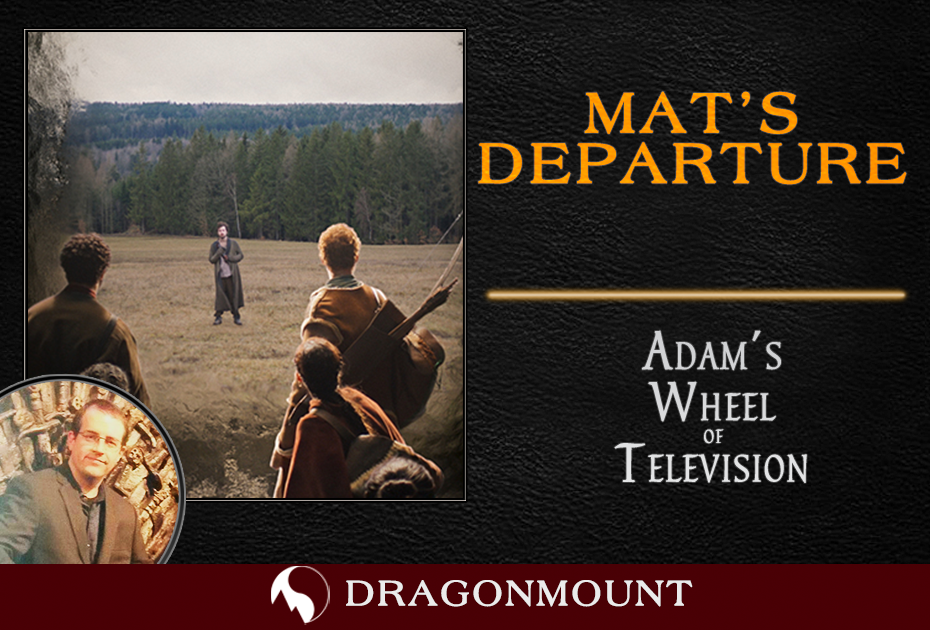
Adam Whitehead is Dragonmount's TV blogger. Adam has been writing about film and television, The Wheel of Time, and other genre fiction for over fifteen years, and was a finalist for the Hugo Award for Best Fan Writer in 2020. Be sure to check out his websites, The Wertzone and Atlas of Ice and Fire (including The Wheel of Time Atlas!) as well as his Patreon. As discussed previously, it’s been known for some time that the role of Mat Cauthon had been recast for the Wheel of Time TV show. Actor Barney Harris played the role in six episodes of the first season before departing, and actor Dónal Finn has been hired to replace him for the second season. The reasons for Barney’s departure have not been given, and given that NDAs and legal agreements are presumably in place, are not likely to be revealed in the near future. As such, we should note in discussing this topic that no negative connotations to the situation should be implied. What is interesting is how the show had to adapt on the fly to the news. To recap, the first season of The Wheel of Time started shooting on 19 November 2019. On 15 March 2020, production of the first season was halted during the initial stages of the COVID19 pandemic. Fortuitously, 15 March was the Sunday at the end of the third block of shooting, with filming concluded for the bulk of Episodes 1-6. The only material missing from these episodes was pickup shots in Spain, for the scenes of Logain in Ghealdan at the start of Episode 4. This allowed the post-production team to put together edits of the first six episodes and for the vfx team to get to work on them. Filming resumed on the final block of shooting, comprising Episodes 7 and 8, in early September 2020. Most of the material for those two episodes was shot before filming was suspended a second time in early November 2020, due to a huge outbreak of coronavirus in the Czech Republic. The pickup shots in Spain were able to go ahead, as Spain was handling the pandemic better at that point in time. Shooting for the outstanding material resumed in April 2021 and wrapped on or around Friday 14 May 2021. Filming on Season 2 began two months later, on 19 July. Amazon confirmed the recasting of Mat on 21 September. Based on what happened in Episode 6, The Flame of Tar Valon, it now appears that Barney Harris did not return to the role of Mat Cauthon after the initial COVID outbreak and resulting shutdown in March-September 2020. This left the production in a somewhat awkward place, as they did not want to necessarily recast Mat immediately (going from one actor playing Mat in Episodes 1-6 and a different one in Episodes 7-8 would be jarring, at best) but they had to find a way of removing Mat from the narrative in a way that made sense and did not involve any new filming with Harris, who presumably was not available at all. I strongly suspect that in the initial shoot, Mat entered the Ways with the rest of the characters and the episode ended perhaps on a foreboding note with the Waygate closing behind them. This left the writers with a difficult job of trying to explain Mat’s absence. Opening Episode 7, The Dark Along the Ways, ten minutes later with the characters saying, “I can’t believe we somehow lost Mat. Weird, huh? Anyway, let’s move on,” was clearly unappealing, and the cost of producing a CG replica of Barney Harris to walk along with the team before being written out was likely regarded as massively cost-prohibitive, not to mention weird. The best option, or at least the best of a poor choice of options, was to remove Mat using the footage they already had in the can, and the fact that although they could not shoot new Mat material, they could shoot new reaction shots from the other actors. Amazon, it turns out, had form for this kind of on-the-fly adaptation. Cas Anvar played the character of Alex Kamal on the first five seasons of The Expanse, but after work on Season 5 was completed but before it aired, allegations of improper conduct surfaced against Anvar (we note, again, that no information has been given about why Harris was replaced and it should not be suggested this was down to any kind of improper behaviour to our knowledge). Anvar was removed from the cast and the production team were left with how to handle this in the edit. The solution they chose was that ace pilot Alex should die from a brain haemorrhage brought about by high-gravity spacecraft manoeuvres, an ongoing and frequently-mentioned risk in the setting. Fortunately, this was even discussed in material filmed for the Season 5 finale, which they could re-emphasise in the edit. They had Alex die off-camera between shots, and then froze a shot of Alex in the cockpit, making it look like he’d expired, and added some CG blood floating in the air to sell the illusion. Also fortunately, the team were shooting the start of Season 6 a week before Season 5 aired. This allowed them to re-shoot material from the end of the Season 5 finale to reflect on the character’s death. The only major technical obstacle was that Alex was present at a reception scene following his character’s newly-created death, which required the CG team to paint him out of every shot after the editors re-edited the sequence to use angles and shots avoiding his presence wherever possible. Although slightly awkward, the edit was broadly successful. For The Wheel of Time, a similar process seems to have been followed. The original material for the episode included lines of Mat being reluctant to enter the Ways, presumably just as character banter before being encouraged to join the rest of the team. By focusing on this line more than was originally intended, the editors could make it appear that this was Mat genuinely feeling unable to carry on with the mission. The shots of the other characters entering the Ways and then reacting to Mat staying behind were likely re-filmed when shooting on Episode 7 resumed, and dropped into the end of Episode 6. Different shots of Mat outside the Ways were then used and dropped into the back of the shot to show him staying back as everyone else entered the Waygate. It is, unavoidably, an awkward change to Mat’s story, although it is helped by the fact that Mat is not thinking clearly due to his association with the cursed dagger from Shadar Logoth. How well the recasting is handled will depend on the other characters' reactions to Mat’s departure in the next two episodes, and how his return in early Season 2 is handled. It is a good reminder that shooting a TV show is an uncertain business, and creatively responding to unforeseen events is a key part of the job of the production team. EDIT: I've seen unpleasant rumours spreading that Barney Harris did not return to the project due to allegedly not being in favour of COVID vaccinations, which were required for filming to resume. This story is false and malicious. Production on The Wheel of Time resumed in September 2020, three months before the first COVID vaccines were available in the UK and EU and more like seven or eight months before they were readily available to people in their 20s. To our knowledge, Harris did not return to the shoot in September 2020 when the vaccines were still unavailable and nobody was vaccinated. Whatever his reason for not returning, it was completely unrelated to vaccinations. As usual, please continue to follow developments on our casting and news pages and the forum and stay tuned for more info as we get it.
-Dragonmount-Banner-Ads-1200x280.gif.ed90097d91aa5c65a5c17fab3b59c6f2.gif)
-Dragonmount-Banner-Ads-728x90.gif.a2f99d762ad611c51fbffc8b25a4efb4.gif)
-Dragonmount-Banner-Ads-320x100.gif.a233f9b759ce2a0c82ee7b9e890e85dd.gif)











.jpg.b7a8ed0c6c6b6db6eaa89411a06d40a5.jpg)
.gif.42a259ec4461f639cc9bc78adbc6ff0e.gif)